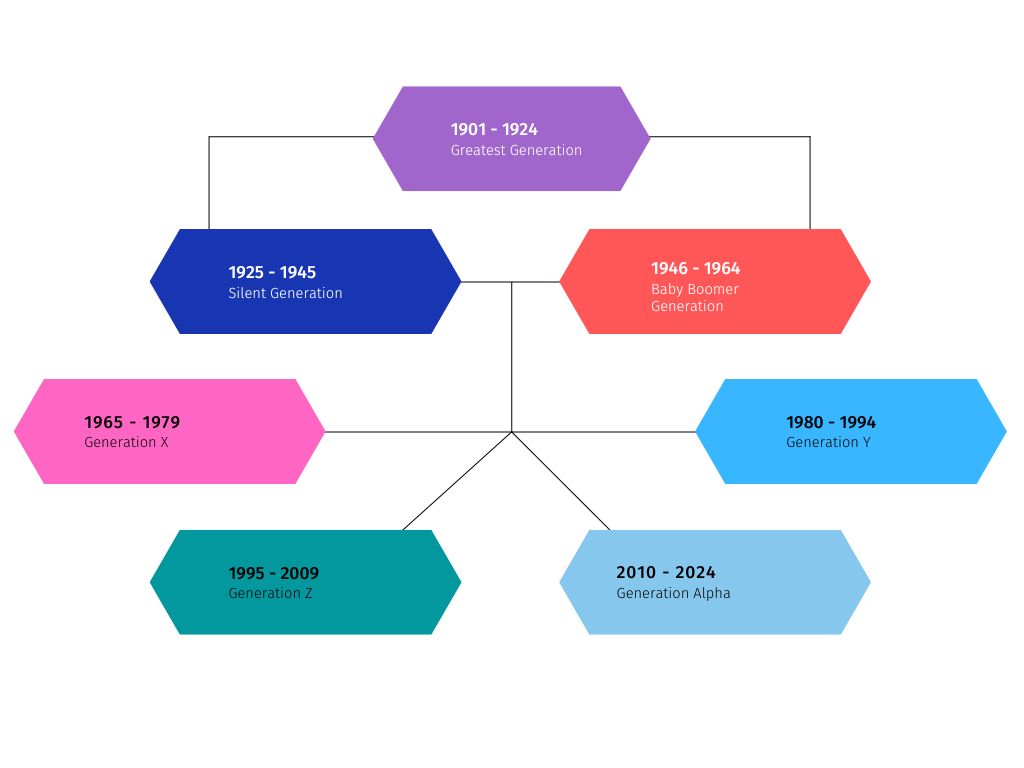The generation years chart and timeline describe the 20th and 21st century generations based on birth years and demographic profiles. The timeline begins with the Greatest Generation in the 20th century, and ends with Generation Alpha in the 21st century.
The collective birth years for these generations range between 13 and 23. To illustrate, the birth years for the Greatest Generation span 23 years (1901 to 1924), and 15 years (2010 and 2024) for Generation Alpha.
While age is an important yardstick in classifying these demographic cohorts, additional factors illustrate the similarities and differences in cohort behavior and life preferences.
In particular, the cohorts share unique characteristics and experiences in parenting, cultural leanings, religious belief, political viewpoints, and social – economic wellbeing. These ideals and values are shaped by existing trends in politics, wars, globalization, and advances in technology.
Technology actually became an important factor of reference, starting with the Millennial generation.
NOTE:
The United States, Western Europe, and the rest of the developed world have documented demographic cohorts for many decades. The developing world only began collecting its data due to the reach of technology and globalization.
Generation Years Chart
The generations chart below shows the generation names and corresponding birth years. Note that the age brackets mentioned here may not necessarily reflect universal cut-off dates. Different countries and sources will quote varying generational timelines for scholarly and other reasons.
The differences are however minimal and do not alter the overall structure of the cohorts.

Generation Years Timeline
This section describes the 7 generation cohorts, their birth years, and characteristics. It is important to note that the characteristics of the cohorts are not entirely universal.
There is a great deal of diversity within each generation, and individuals within each generation may not share all the characteristics associated with their cohort.
Additionally, the boundaries between generations are not always universal. For example, some individuals born in the early 1990s may identify more with Generation Z, while others may identify more with millenials.
Despite these limitations, generational labeling can be a useful tool for scholarly reasons, and understanding how differently people from select generations think, feel, and behave.
1. The Greatest Generation: (1901 – 1924)
The Greatest Generation is the first cohort in our list. It was born between 1901 and 1924. The G.I Generation and the WWII Generation are the other names for the cohort, while Australians call it the Federation Generation.
This generation was considered GREAT due to its remarkable determination and resilience during WW1, WW2, and the Great Depression.
This generation fought willingly and sacrificed everything for their country. They were vigilant during the two wars, because they believed it was the right thing to do. Just as well, they stayed calm during the tough years of the depression.
The iconic journalist, Tom Brokaw, coined the name for this cohort. The name became popular after he published a book titled The Greatest Generation.
In the book, he credits the cohort for staying vigilant at a time when the world faced extreme challenges. By all means, everyone at the time gave true meaning to the words courage, sacrifice, and honor.
He lauded individuals such as Charles Van Gorder (a medical doctor), Senator Daniel Inouye, and Martha Settle Putney. The latter was a black member of Women’s Army Corps – WAC. He also praised George H. W. Bush (pilot), as part of the many people who served their country with honor and courage.
Tom Brokaw lauded the following traits in the cohort:
- Integrity
- Humility
- Work ethics
- Financial ethics
- A big sense of responsibility
Ronald Reagan (1911), John F Kennedy (1917), and Jimmy Carter (1924) are three other famous Americans from the Greatest Generation years.
2. The Silent Generation: (1925 – 1945)
The Silent Generation is the second cohort in our list. The age bracket for this generation spanned 20 years, from 1925 to 1945. The generation was also known as Traditionalists because of their loyalty, humility, and reverence towards authority.
They said very little and worked hard to get by. This probably contributed to their civic approach to work & lifestyle. The effects of the two world wars greatly shaped their characters and preferences in life. The Great Depression (1929 – 1939) and the Dust Bowl, which devastated farmlands in the 30s, also influenced their general wellbeing.
They also grew up under firm parenting, given that they were children of fighters. They were nurtured to be seen rather than heard!
Time Magazine coined the term “Silent Generation” in a 1951 article titled The Younger Generation. Time slammed this group for lacking ambition and drive.
It was perhaps harshly labeled unimaginative, cautious, and withdrawn – perhaps too harshly.
In scathing words, the article notes,
The most startling fact about the younger generation is its silence. With some rare exceptions, youth is nowhere near the rostrum. By comparison with the Flaming Youth of their fathers & mothers, today’s younger generation is a still, small flame. It does not issue manifestoes, make speeches or carry posters.
People: THE YOUNGER GENERATION
To be honest, the Silent Generation was stuck between two influential generations: the Greatest and the Baby Boomers. The Baby Boomer generation, which succeeded them, lived through a fairy tale lifestyle because of their hard work.
To top it all, the Boomers took over the world as the Silent Generation looked on.
In the US alone, the Silent Generation has had to witness the Boomers monopolize the presidency for decades. While they have only one to their name – Joe Bidden, Boomer presidents include George W Bush, Bill Clinton, Barack Obama, and Donald Trump.
General traits of the Silent Generation:
- Loyal
- Determined
- Respectful
- Thrifty
Warren Buffet (1930), Joe Bidden (1942), Malcolm X (1925), Marilyn Monroe (1926), Harry Belafonte (1927), and Mohammed Ali (1941), are of the Silent Generation. These lived to show the world they were not necessarily silent!
3. The Baby Boomer Generation: (1946 – 1964)
The Baby Boomer birth years lasted between 1946 and 1964, spanning a period of 18 years. Baby boomers were born soon after WWII, at a time of revived hope in the US, in particular.
Coupled with the hard work put in by the two previous generations, Boomers had peaceful and ample time to figure out what to do in the future.
The post-war years allowed them to do what the previous generations had failed to do. They saw a future of prosperity, which also encouraged young couples to give birth to many children.
The boom lasted approximately 20 years.
The bumper birth rate created a new era of consumerism that helped drive the US economy. This also created a new breed of rich and mindless individuals.
According to Forbes, the Baby Boomer cohort
became especially well-known for its cultivation of self and its carelessness about material wealth.
The Boom Generation
The name Baby Boomer became popular in 1977, thanks to a Washington Post publication about the future of the world economy.
The phrase referenced to the boom in childbirth following the return of American fighters from war. It eclipsed other titles such as Rock and Roll Generation and Generation Jones.
The Baby Boomer phrase became widely accepted around the world to denote varying opinions and emotions:
- The Chinese through Chairman Mao Zedong used it in the 1960s to encourage conception.
- The Germans used ‘babyboomers’ to refer to the upsurge of babies in the 1960s.
- The Dutch used ‘de baby boomers’ to point out the beneficiaries of wealth through the 1960s.
- The French used ‘les baby-boomers’ to refer to a student generation that rioted in 1968.
- The Italians view the birth years of the 1960s as byproducts of the economic boom at the time.
A few notable characteristics of Baby Boomers:
- Ambitious, goal-oriented, and competitive
- Focused and believe in more hours at work
- Some times careless about wealth
- Resourceful and team players
- Bureaucratic
… other notable events:
- Apart from bumper births, other notable events during these years included the Vietnam War and the enactment of the Civil Rights Act in 1964.
- In the US alone, African Americans make up 10 percent, and 8 percent Hispanic of this demographic group. Baby Boomers will account for 20 percent of the American population as they age.
Popular personalities in these generation years are George W Bush (1946), Steve Jobs (1955), Tony Blair (1953), Princess Diana (1961), Jeff Bezos (1964), Nicholas Cage (1964), Johnny Depp (63), Bill Clinton (1946), Barack Obama (1961), Donald Trump (1946), Bill Gates (1955) and George Clooney (1961).
4. Generation X: (1965 – 1979)
The age bracket for Generation X spanned only 14 years, stretching from 1965 to 1979. Also called Baby Buster or Gen X, the cohort reversed the baby boom trend by registering low birth rates!
Gen X just like the Silent Generation, is unfortunately sandwiched between Baby Boomers and Millennials. That is why they are often referred to as the Forgotten Generation!
Photographer Robert Capa came up with the name Generation X, which initially meant ‘unknown’. Generation Xers desired and still prefer not to be defined in any manner.
The name for the generation was made popular by Douglas Coupland, in his book titled Generation X: Tales for an Accelerated Culture. He used the book to tell a story of a group of young men (Gen X) living in their own lost world.
Gen X is also defined by its love for music and art, and actually pioneered pop culture as we know it today. Xers grew up watching lots of TV soaps, and for this, have fond memories of ‘Friends‘ and other popular TV series.
The generation also groomed an increase of single-parents and continues to record higher divorce rates than other generations, right into the 21st Century.
Xers are independent-minded, educated, informal, casual, and entrepreneurial. They have also passed on the same traits to their children, – the Z cohort.
X is also regarded as the last generation to hold dear to its culture and education. It is the last to understand a different culture that reigned before technology became the norm. It is living in a totally new culture and environment in the 21st century!
According to Vanity Fair,
Generation X, the last Americans schooled in the old manner, the last Americans that know how to fold a newspaper, take a joke, and listen to a dirty story without losing their minds.
Following the innovation and distribution of the first lots of microcomputers in the 80s and 90s, Generation X somehow became one of the first to interact with technology.
Finally, Gen Xers, who are well into their 40s and 50s and defined by many cultural identities, such as Parental Advisory, is also touted as the last chance society has to preserve traditional values that are fast becoming extinct.
General characteristics of the Xers:
- Work hard
- Believe in work-life balance
- Independent-minded
- Flexible and direct
- Self-reliant
- Thinkers and embrace feedback
- In debt
- Cynical?
Famous personalities from these generation years: Jay Z (1969), Tiger Woods (1975), Halle Berry (1966), Julia Roberts (1967), Celine Dione (1968), and Will Smith (1968).
5. Generation Y: (1980 – 1994)
Also called Millenials, the Generation Y cohort was born between 1980 and 1994, stretching for 15 years. The Millennial cohort was born at a time when technology was taking true shape, majorly for productivity.
The use of the internet helped them consolidate their grip on technology, and embrace the wide-ranging possibilities in the 21st Century.
The Baby Boom generation happens to be their parents. They called are millenials because they hold the responsibility and opportunity to fully harness the experiences of technology, at the start of the new millennium.
Technology remains critical for driving productivity and has become the tool of choice even at home.
This correlation with the initial years of digital evolution explains why Millenials use technology to extend their reach and venture into global markets. They have used these to drive and shape economies around the world.
Millennials have grown up in a time of rapid change, giving them a set of priorities and expectations sharply different from previous generations.
Who are they?
Many millennial parents are champions of a new age of parenting, way beyond Baby Boomers and Generation X. Apart from being ethnically and racially diverse, they are more likely to entertain their children donning wearable gadgets. They also allow their kids to try out different AI innovations.
In a 2018 survey carried out by Go Daddy, 48% of millennial parents deemed it fine for their Alpha children to have an online experience, compared to only 27% of Gen Xers.
The general traits of Millennials:
- Socially driven
- Ethically diverse
- Tech-driven and curious
- Educated and multi-career based
- Financially conscious and therefore stable
- Poor at interpersonal skills
- Less religious
Popular figures from this era: Mark Zuckerberg (1984), Taylor Swift (1989), Christina Aguilera (1980), Nicki Minaj (1982), Rihanna (1988), and Beyoncé (1981).
6. Generation Z: (1995 – 2009)
The Generation Z birth years lasted only 13 years, stretching from 1995 to 2009. The Zs are also known as the children of Generation X.
As of 2024, when the last Alpha will be born, they will total close to 27 percent of the workforce, according to McCrindle.
The Z or iGen, just like the previous generation Y, has immersed itself deep in the world of the internet and technology. Unlike their predecessors, they exhibit a sense of euphoria and hope to avoid past mistakes by earlier generations.
They also approach fancy lifestyles rather passively in comparison to Millennials. For example, they learn to drive late and become sexually active much later in life. They also indulge in alcoholic beverages a little later than the previous generations.
Instead, they spend most of the time planning for their future amidst the tight work conditions around the world.
Their concentration levels have been greatly influenced by the amount of information at their disposal. Hence, they are always multi-tasking and have developed short attention spans.
They may seem not to have time for serious stuff at school and at work, but experts predict they will be more goal-oriented and pragmatic.
These traits have led experts to somehow liken them to the Silent generation of the 1920s to 1940s.
Characteristics of Z:
- Tech-savvy and ‘always on‘
- Poor at interpersonal skills
- Reduced attention span
- Indoor generation
- Ethnically diverse
- Set for online social interactions
- Less religious
- Personalized learning
Popular iGens: Baby Ariel (2000), Zendaya (1996), and Baby Kaely (2004).
7. Generation Alpha: (2010 – 2024)
Generation Alpha is the latest in the chart of generation cohorts, and one that best suits the digital native description.
The Alpha cohort brings together people born between 2010 and 2024, spanning a period of 15 years. The cohort replaced Generation Z whose birth years fall between 1996 and 2009.
Estimates show that 2 million Alphas are born every week. And they will total 2 billion by the year 2024. As of 2023, the eldest Alpha child is 13 years old.
… Alpha and technology
The year the first Alpha child was born (2010) is the same year the first iPad was released. The iPad and other digital gadgets immediately became part of their lives.
The iPad and similar tools are now used for collaborative learning and have shaped both Alpha and Gen Z lives.
Alphas will probably be the most transformative generation yet, at least until the Beta Generation arrives. Alphas are born in a world saturated with gadgets and are experiencing the implementation of new technology innovations as years go by.
As much as they are immersed deep in touchscreens, their interaction with technology and the bigger picture of life is changing and will evolve drastically in the next decades.
The rapid advancements in artificial intelligence mean that interaction with the digital ecosystem will have to be responsive enough to suit their imagination.
Teen and adult Alphas will probably not use apps and cell phones the way we use them today. With the onset of the Metaverse and the Betaverse they will likely spend a lot of time exploring the virtual world and spaces.
They will bury themselves in games, go shopping, travel the world, chat with friends while hidden behind virtual reality (VR) headsets and glasses.
The first movers of the Metaverse just might be Generation Alpha – the most technologically integrated generation of our lifetime.
Mccrindle
Lastly, the outbreak of the COVID-19 pandemic in early 2020 impacted Alpha childhood development in many ways. They spent more time at home, missed out on school, and had their social lives impacted due to social distancing.
On a positive note, the Alpha diet, hygiene and overall health got better: they were fed better meals and slept more and better.
General traits of Generation Alpha:
- Tech-savvy and ‘always on‘
- Will need 21st century skills in the classroom
- Will readily embrace metaverse devices such as VR and AR
- Poor at interpersonal skills
- Will probably have reduced attention span
- Less religious
- Ethnically diverse & aware
- Largely an indoor generation
The Final Note
While the timeline above provides a snapshot of distinct generations, the reality is far more complex and interconnected. Each individual is shaped by unique experiences beyond generational labels.
Perhaps the most valuable insight here is the understanding that every generation has something to offer, and true progress lies in bridging the gaps and learning from each other.
As we look back at the legacies of past generations and the horizon of Generation Alpha’s future, a compelling question remains: what will define our own generation? What values will we uphold, what challenges will we overcome, and what stories will we leave behind?
The answer lies in the choices we make today, and the ripples they create in the generations to come.




Leave a Reply